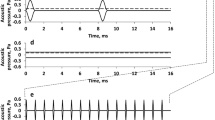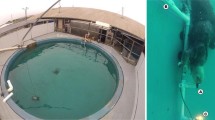Abstract
Ice-dwelling beluga whales are increasingly being exposed to anthropogenic loud sounds. Beluga’s hearing sensitivity measured during a warning sound just preceding a loud sound was tested using pip-train stimuli and auditory evoked potential recording. When the test/warning stimulus with a frequency of 32 or 45 kHz preceded the loud sound with a frequency of 32 kHz and a sound pressure level of 153 dB re 1 μPa, 2 s, hearing thresholds before the loud sound increased relative to the baseline. The threshold increased up to 15 dB for the test frequency of 45 kHz and up to 13 dB for the test frequency of 32 kHz. These threshold increases were observed during two sessions of 36 trials each. Extinction tests revealed no change during three experimental sessions followed by a jump-like return to baseline thresholds. The low exposure level producing the hearing-dampening effect (156 dB re 1 µPa2s in each trial), and the manner of extinction, may be considered as evidence that the observed hearing threshold increases were a demonstration of conditioned dampening of hearing when the whale anticipated the quick appearance of a loud sound in the same way demonstrated in the false killer whale and bottlenose dolphin.






Similar content being viewed by others
Abbreviations
- AEP:
-
Auditory evoked potential
- RFR:
-
Rate following response
- SPL:
-
Sound pressure level
- SEL:
-
Sound exposure level
- TTS:
-
Temporary threshold shift
References
Au WW, Carder D, Penner R, Scronce BL (1985) Demonstration of adaptation in beluga whale echolocation signals. J Acous Soc Am 77:726–730
Awbrey FT, Thomas J, Kastelein R (1988) Low-frequency underwater hearing sensitivity in belugas, Delphinapterus leucas. J Acous Soc Am 84:2273–2275
Black AH (1971) Autonomic aversive conditioning in infrahuman subjects. In: Brush F (ed) Aversive conditioning and learning. Academic Press, New York, pp 3–104
Castellote M, Mooney T, Quakenbush L, Hobbs R, Goertz C, Gaglione E (2014) Baseline hearing abilities and variability in wild beluga whales (Delphinapterus leucas). J Exp Biol 217:1682–1691
Finneran JJ, Schlundt C, Carder D, Clark J, Young J, Gaspin J, Ridgway S (2000) Auditory and behavioral responses of bottlenose dolphins (Tursiops truncatus) and a beluga whale (Delphinapterus leucas) to impulsive sounds resembling distant signatures of underwater explosions. J Acous Soc Am 108:417–431
Finneran JJ, Schlundt C, Branstetter B, Dear R (2007) Assessing temporary threshold shift in a bottlenose dolphin (Tursiops truncatus) using multiple simultaneous auditory evoked potentials. J Acous Soc Am 122:1249–1264
Finneran JJ, Carder DA, Schlundt CE, Dear R (2010) Temporary threshold shift in a bottlenose dolphin (Tursiops truncatus) exposed to intermittent tones. J Acoust Soc Am 127:3267–3272
Huntington HP (2009) A preliminary assessment of threats to arctic marine mammals and their conservation in the coming decades. Marine Policy 33:77–82
Jefferson TA, Karkzmarski L, Laidre K, O’Corry-Crowe G, Reeves R, Rojas-Bracho L, Secchi Slooten E, Smith B, Wang J, Zhou K (2012) Delphinapterus leucas. The IUCN red list of threatened species. Version 2014.3. www.iucnredlist.org
Klishin VO, Popov V, Supin A (2000) Hearing capabilities of a beluga whale, Delphinapterus leucas. Aq Mamm 26:212–228
Lesage V, Barrette C, Kingsley M, Sjare B (1999) The effect of vessel noise on the vocal behavior of belugas in the St. Lawrence River estuary, Canada. Mar Mamm Sci 15:65–84
Lowry L, O’Corry-Crowe G, Goodman D (2012) Delphinapterus leucas (Cook Inlet subpopulation). The IUCN red list of threatened species. Version 2014.3. www.iucnredlist.org
Mooney TA, Nachtigall P, Castellote M, Taylor K, Pacini A, Estaban JA (2008) Hearing pathways and directional sensitivity of the beluga whale, Delphinapterus leucas. J Exp Marine Biol Ecol 362:108–116
Nachtigall PE, Schuller G (2014) Hearing during echolocation in Whales and bats. In: Surrlyke AM, Nachtigall P, Popper A, Fay R (eds) Biosonar. Springer, New York, pp 143–167
Nachtigall PE, Supin A (2008) A false killer whale adjusts its hearing when it echolocates. J Exp Biol 211:1714–1718
Nachtigall PE, Supin A (2013) A false killer whale reduces its hearing sensitivity when a loud sound is preceded by a warning. J Exp Biol 216:3062–3070
Nachtigall PE, Supin A (2014) Conditioned hearing sensitivity reduction in a bottlenose dolphin (Tursiops truncatus). J Exp Biol 217:2806–2813
Nachtigall PE, Pawloski J, Au W (2003) Temporary threshold shifts and recovery following noise exposure in the Atlantic bottlenosed dolphin (Tursiops truncatus). J Acous Soc Am 113:3425–3429
Popov V, Supin A (2009) Comparison of directional selectivity of hearing in a beluga whale and a bottlenose dolphin. J Acous Soc Am 126:1581–1587
Popov VV, Supin A, Wang D, Wang D, Dong L, Wang S (2011) Noise-induced temporary threshold shift and recovery in Yangtze finless porpoises Neophocaena phocaenoides asiaeorientalis. J Acous Soc Am 130:574–584
Popov VV, Supin A, Rozhnov V, Nechaev D, Sysueva E (2014) The limits of applicability of the sound exposure level (SEL) metric to temporal threshold shifts (TTS) in beluga whales, Delphinapterus leucas. J Exp Biol 217:1804–1810
Scheifele PM, Andrew S, Cooper R, Darre M, Musiek F, Max L (2005) Indication of a Lombard vocal response in the St. Lawrence River beluga. J Acous Soc Am 117:1486–1492
Schlundt CE, Finneran J, Carder D, Ridgway S (2000) Temporary shift in masked hearing thresholds of bottlenose dolphins, Tursiops truncatus, and white whales, Delphinapterus leucas, after exposure to intense tones. J Acous Soc Am 107:3496–3508
Simard Y, Roy N, Giard S, Gervaise C, Conversano M, Ménard N (2010) Estimating whale density from their whistling activity: example with St. Lawrence beluga. Appl Acous 71:1081–1086
Supin AY, Popov V (2007) Improved techniques of evoked-potential audiometry in odontocetes. Aq Mam 33:14–23
Supin AY, Popov V, Mass A (2001) The sensory physiology of aquatic mammals. Springer Science & Business Media, Kluwer, New York
Supin AYa, Nachtigall P (2013) Gain control in the sonar of odontocetes. J Com Phys A 199:471–478
Supin AY, Nachtigall P, Au W, Breese M (2004) The interaction of outgoing echolocation pulses and echoes in the false killer whale’s auditory system: evoked-potential study. J Acous Soc Am 115:3218–3225
Supin AY, Nachtigall P, Breese M (2008) Hearing sensitivity during target presence and absence while a whale echolocates. J Acous Soc Am 123:534–541
White J, Norris J, Ljungblad D, Barton K, di Sciara G (1978) Auditory thresholds of two beluga whales (Delphinapterus leucas), Hubbs/Sea World Research Institute Technical Report: pp 78–109
Acknowledgments
This manuscript is contribution number XXXX of the Hawaii Institute of Marine Biology. Significant help from the trainers: Hector Canatelli, Felipe Cabildo, Ivan Soto, Almundena Mena, and Araceli Albarracín; the chief veterinarian, Daniel Garcia, and the Director, Pablo Areitio of the Oceanographic is gratefully acknowledged.
Funding
This research project was supported by the sale of the Hawaii Institute of Marine Biology’s laboratory-born dolphin Ho’olono. Additional funding was supplied by Exxon Mobil’s Ocean Science Program with the helpful assistance of Dr. Gary Isaksen.
Animal care
The animal in this experiment was treated well within the guidelines of international ethical standards of animal care. The protocol for the experiment was approved by the Animal Care and Utilization Committee of the University of Hawaii and the Veterinary staff of Oceanographic.
Author information
Authors and Affiliations
Corresponding author
Rights and permissions
About this article
Cite this article
Nachtigall, P.E., Supin, A.Y., Estaban, JA. et al. Learning and extinction of conditioned hearing sensation change in the beluga whale (Delphinapterus leucas). J Comp Physiol A 202, 105–113 (2016). https://doi.org/10.1007/s00359-015-1056-x
Received:
Revised:
Accepted:
Published:
Issue Date:
DOI: https://doi.org/10.1007/s00359-015-1056-x




